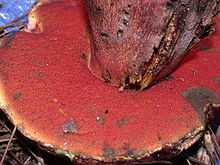Boletus pulcherrimus
| ||||||||||||||||||||||||||||||||||||||||||||||||
Boletus pulcherrimus, commonly known as Alice Eastwood's boletus or the red-pored bolete, is a species of mushroom in the Boletaceae family. It is a large bolete from Western North America with distinguishing features that include a finely netted surface on the upper third of the stem, a red to brown cap and stem color, and red pores that stain blue upon injury. Formerly known as B. eastwoodiae, the original specimen was reviewed in 1976 and found to be B. satanas. To date it is the only bolete that has been implicated in the death of someone consuming it; a couple developed gastrointestinal symptoms in 1994 after eating this fungus with the husband succumbing. Autopsy revealed infarction of the midgut.[1]
Taxonomy
The species was described in 1976 by American mycologists Harry D. Thiers and Roy E. Halling as Boletus pulcherrimus, from the Latin pulcherrimus, meaning "very pretty".[2] The original material collected by Alice Eastwood of the California Academy of Sciences and sent to William Murrill who described it as Boletus eastwoodiae was found on examination to belong to Boletus satanas.[3] The common names of B. pulcherrimus include "Alice Eastwood's boletus",[4] and the "red-pored bolete".[5]
Description
Colored various shades of olive- to reddish-brown, the cap may sometimes reach 25 centimeters (10 in) in diameter and is convex in shape before flattening at maturity. The cap surface may be smooth or velvety when young, but may be scaled in older specimens; the margin of the cap is curved inwards in young specimens but rolls out and flattens as it matures.[3]
- Microscopic characters
The spores are spindle-shaped or elliptical, thick-walled, smooth, and have dimensions of 13–16 by 5.5–6.5 μm. The basidia, the spore-bearing cells, are club-shaped (clavate), attached to 1 to 4 spores, and have dimensions of 35–90 by 9–12 μm. The cystidia (sterile, non-spore-bearing cells found interspersed among the basidia) in the hymenium have dimensions of 33–60 by 8–12 μm. Clamp connections are absent in the hyphae of B. pulcherrimus.[3]
Similar species
Although the relatively large fruiting bodies of B. pulcherrimus are distinctive, they might be confused with superficially similar species, such as Boletus satanas; the latter species has a much thicker stalk. Another similar species is B. haematinus, which may be distinguished by its yellower stem and cap colors that are various shades of brown.[9] Boletus erythropus also has red pores, but does not have reticulations on the stem.[8]
Distribution and habitat

Boletus pulcherrimus is found in western North America, from New Mexico and California to Washington, and may feasibly occur in British Columbia, Canada. One source notes it grows at low altitudes in the Cascade Range and Olympic Mountains;[7] another claims it grows at high elevations, over 5,000 ft (1,500 m).[8] Fruiting in autumn, it grows singly or in groups (although another source claims "never in groups")[10] in humus in mixed woodlands.[4][5] In the original publication describing the species, Thiers and Halling note that it is associated with forests containing tanbark oaks (Lithocarpus densiflora), Douglas fir (Pseudotsuga menziesii), and Giant Fir (Abies grandis).[3] Smith and Weber mention increased fruitings after warm heavy fall rains following a humid summer.[11]
Toxicity
In general, blue-staining red-pored boletes should be avoided for consumption.[8] Thiers warned this species may be toxic after being alerted to severe gastrointestinal symptoms in one who had merely tasted it.[12] Years later, in 1994, a couple developed gastrointestinal symptoms after eating this fungus and the husband died as a result. A subsequent autopsy revealed that the man had suffered an infarction of the midgut. Boletus pulcherrimus is therefore the only bolete that has been implicated in the death of someone consuming it.[1] It is known to contain low levels of muscarine, a peripheral nervous system toxin.[13]
See also
References
- ↑ 1.0 1.1 Benjamin DR. Red-pored boletes. pp. 359–60. in: Mushrooms: Poisons and Panaceas—a Handbook for Naturalists, Mycologists and Physicians. New York: WH Freeman and Company. 1995.
- ↑ Simpson DP. (1979). Cassell's Latin Dictionary (5 ed.). London: Cassell Ltd. p. 883. ISBN 0-304-52257-0.
- ↑ 3.0 3.1 3.2 3.3 3.4 Thiers HD, Halling RE. (1976). "California Boletes V:Two New Species of Boletus". Mycologia (PDF) (Mycological Society of America) 68 (5): 976–83. doi:10.2307/3758713. JSTOR 3758713.
- ↑ 4.0 4.1 Ammirati JF, Traquair JA, Horgen PA. (1985). Poisonous Mushrooms of the Northern United States and Canada. Minneapolis: University of Minnesota Press. pp. 241–42. ISBN 0-8166-1407-5.
- ↑ 5.0 5.1 5.2 Arora D. (1986). Mushrooms Demystified: A Comprehensive Guide to the Fleshy Fungi. Berkeley, CA: Ten Speed Press. p. 528. ISBN 0-89815-169-4.
- ↑ 6.0 6.1 6.2 Wood M, Stevens F (2009). "California Fungi—Boletus pulcherrimus". California Fungi. Retrieved 2009-08-19.
- ↑ 7.0 7.1 Ammirati JF, McKenny M, Stuntz DE. (1987). The New Savory Wild Mushroom. Seattle: University of Washington Press. p. 9. ISBN 0-295-96480-4.
- ↑ 8.0 8.1 8.2 8.3 Tylukti EE. (1987). Mushrooms of Idaho and the Pacific Northwest Vol. 2 Non-gilled hymenomycetes. Moscow, Idaho: The University of Idaho Press. pp. 26–28. ISBN 0-89301-097-9.
- ↑ Arora D. (1991). All that the Rain Promises and more: a Hip Pocket Guide to Western Mushrooms. Berkeley, Calif: Ten Speed Press. p. 167. ISBN 0-89815-388-3.
- ↑ Castellano MA, Smith JE, O'Dell T, Cázares E, Nugent S. (1999). Handbook to Strategy 1 Fungal Species in the Northwest Forest Plan: Boletus pulcherrimus. Portland, OR: U.S. Department of Agriculture, Forest Service, Pacific Northwest Research Station. Retrieved 2009-08-19.
- ↑ Weber NS, Smith AH. (1980). The Mushroom Hunter's Field Guide. Ann Arbor, Mich: University of Michigan Press. p. 105. ISBN 0-472-85610-3.
- ↑ Thiers HD. (1975). California Mushrooms—A Field Guide to the Boletes. New York: Hafner Press. ISBN 0-02-853410-7.
- ↑ Miller HR, Miller OK. (2006). North American Mushrooms: a Field Guide to Edible and Inedible Fungi. Guilford, Conn: Falcon Guide. p. 381. ISBN 0-7627-3109-5.
